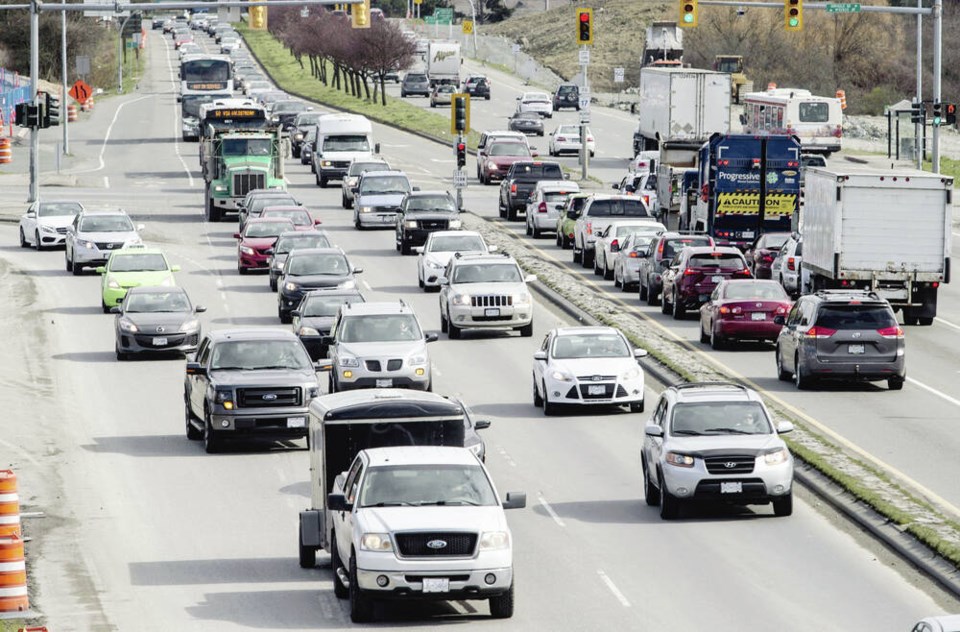I was meeting a friend in View Royal last week and thought I’d get a jump on the West Shore traffic, formerly known as the Colwood crawl, by going out early. I set out from town about 1:45 naively believing that I‘d be well in front of the CRD’s infamous afternoon commute. Wrong.
There was a three light wait on Admirals to turn onto Island highway. Must be an accident or construction up that way, so I diverted back to Admirals and headed to the Trans-ÎÚÑ»´«Ã½. Surely the highway can’t be backed up — it’s not even 2:00 pm. Wrong.
It was chock-a-block as far as the eye could see going north. I hate leaving early and still being late.
The upside, if there is such a thing in a traffic jam, was that there was a sort of real world demo of “zipper merging” from cars coming onto the highway, and I now had plenty of crawling along time to think about it.
I say this was a “sort of” demo because clearly not everyone was on the same page.
Some drivers merged into the northbound lanes as soon as possible, even crossing a solid white line to squeeze in. Others zipped by on the right to where the right lane ends and they’re forced to move over — if the person on the left will allow it — and clearly not everyone was feeling courteous that day.
So what’s the deal? Move over early if possible? Then you wait and watch as the right laners keep zipping by to the front of the queue. Is zipping past everyone to get to the front the best way? That feels rude for polite Canadian society.
I wimped out and took the middle ground — not moving over to the left immediately but getting in there well before my lane ended. Thanks to the guy in the blue Mazda for your courtesy.
But according to several North American road studies, I was wrong. Moving to the end of a merge lane and “zippering” into traffic flow is viewed as the best and safest way to go.
Why?
Done properly, zipper merging reduces speed in all lanes approaching the choke point and lessens collision potential from unexpected or aggressive lane changes. It also creates a sense for drivers that all lanes are moving equally — taking frustration down as it does so.
That’s logical. If the right hand merge lane is filled right up to the merge point, then no one can zip by.
Apparently that works. A Canadian Automobile Association study shows that zipper merging can reduce choke point congestion by as much as 40%, while a Texas study showed that it can delay the onset of congestion at a merge point by 14 minutes and reduce the lines of cars heading to that point by more than 400 metres.
If saving the environment is also your priority, then zippering is for you. That same CAA study showed that bottle necks created by just four major choke points in ÎÚÑ»´«Ã½’s lower mainland resulted in vehicles spewing an additional 4,000 tonnes of carbon dioxide out of their tailpipes during the 56 day study period.
In 2020, the state of Illinois got serious about the whole issue and enacted a regulation requiring drivers in the through lane to give way to mergers when two lanes become one.
There still isn’t enough buy-in right now to make this work well though. I think the problem is that the last minute charge to the front is still considered by many to be rude.
There are several videos out there, many from the UK for some reason, showing drivers in the through lane working extra hard at blocking out merging vehicles — sometimes driving alongside them for kilometres to deny the “merger” access.
What’s necessary here is more signage explaining what to do. It’s tough to unload rage on those merge lane drivers when there’s a sign, big and bold, saying that they’re actually doing the right thing.
A word of caution though. I wouldn’t advocate zipper merging if a lane is blocked by emergency or service vehicles responding to a highway incident. In those cases, move to the through lane safely — but early — and reduce your speed. Crews blocking a lane in an emergency need as much room as they can get.
The real benefit in the zipper merge is that it actually helps us use two of the most important driving tactics: patience and courtesy.
That won’t work for a few people out there who need that thrill of victory by being in front of “that guy,” even though everyone is wedged in the same traffic jam.
So let the zippers in. You’re doing yourself a favour in the end.
>>> To comment on this article, write a letter to the editor: [email protected]



